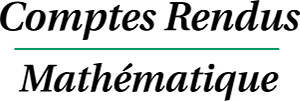Une -forme différentielle θ de classe fermée dans une variété projective complexe lisse X plongée dans l'espace projectif donne naissance à une « extension » à l'espace projectif comme courant fermé. Ceci signifie que le nombre d'intersections de ce courant avec l'image directe par l'injection canonique de X d'une forme test dans X est égal à la valeur de θ sur cette forme test, et que sa restriction à X s'obtient au moyen de l'éclatement de centre X. On définit ainsi une transformation intégrale donnée par un noyau qui est un courant fermé dans , et qui est utilisée pour apporter une réponse à un problème de Grothendieck. Ce transformé est encore défini pour un cycle algébrique de codimension q au lieu de la -forme différentielle. On obtient une caractérisation des intersections complètes par la positivité du transformé. On obtient aussi une version du théorème de Lefschetz sur la section hyperplane, qui dit que la classe de cohomologie provient de la section hyperplane lorsque l'intersection avec X est transverse en dehors de la section hyperplane.
A closed smooth differential -form θ in a complex projective manifold X embedded in the projective space gives rise to an “extension” to the projective space as a closed current. This means that the intersection number of this current with the direct image by the canonical injection of X of a smooth test form on X is equal to the value of θ on this test form, and that its restriction to X is obtained by means of the blow up with center X. We define in this way an integral transform given by a kernel which is a closed current in , and which is used to bring an answer to a problem of Grothendieck. This transform is still defined for an algebraic cycle of codimension q instead of the differential -form. We obtain a characterization of the complete intersections by the positivity of the transform. Moreover, we obtain a version of the Lefschetz theorem on the hyperplane section stating that the cohomology class arises from the hyperplane section when the intersection with X is transverse outside the hyperplane section.
Accepté le :
Publié le :
@article{CRMATH_2016__354_6_583_0,
author = {Michel M\'eo},
title = {Extension de courants ferm\'es \`a l'espace projectif},
journal = {Comptes Rendus. Math\'ematique},
pages = {583--588},
publisher = {Elsevier},
volume = {354},
number = {6},
year = {2016},
doi = {10.1016/j.crma.2016.03.010},
language = {fr},
}
Michel Méo. Extension de courants fermés à l'espace projectif. Comptes Rendus. Mathématique, Volume 354 (2016) no. 6, pp. 583-588. doi : 10.1016/j.crma.2016.03.010. https://comptes-rendus.academie-sciences.fr/mathematique/articles/10.1016/j.crma.2016.03.010/
[1] Sur l'homologie des courants à support dans un ensemble semi-analytique, Mém. Soc. Math. Fr., Volume 38 (1974), pp. 35-43
[1] The -equation on a positive current, Invent. Math., Volume 147 (2002), pp. 371-428
[2] Formules intégrales pour les formes différentielles de type dans les variétés de Stein, Ann. Sci. Éc. Norm. Super. (4), Volume 20 (1987), pp. 579-598
[3] Residues and Chern classes, Proc. Symp. Pure Math., Volume XXVII (1975) no. 2, pp. 91-97
[4] Residual intersections and Todd's formula for the double locus of a morphism, Acta Math., Volume 140 (1978), pp. 75-92
Cité par Sources :
Commentaires - Politique


